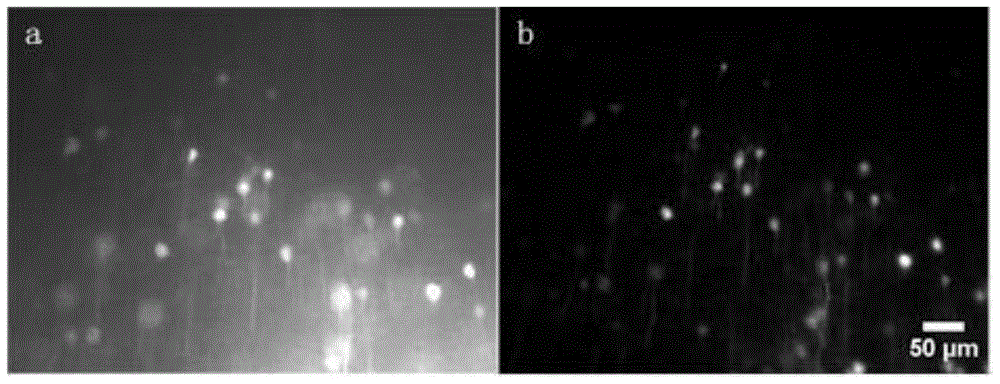A method for reducing background fluorescence of biological samples
A biological sample and fluorescence technology, which is applied in the field of reducing the background fluorescence of biological samples, can solve the problems of no research on biological tissue blocks, cumbersome experimental procedures, uneven staining, etc., and achieve the effects of short processing time, reduced background fluorescence, and simple operation steps
- Summary
- Abstract
- Description
- Claims
- Application Information
AI Technical Summary
Problems solved by technology
Method used
Image
Examples
Embodiment 1
[0022] This embodiment provides a method for reducing the background fluorescence of biological samples, comprising the following steps:
[0023] The biological sample is a Thy1-eYFP-H mouse brain block with a thickness of 3 mm, and the imaging system is an Olympus IX71 wide-field fluorescence microscope.
[0024] (1) Thy1-eYFP-H line transgenic mice were anesthetized with 1% pentobarbital sodium, and perfused with 0.01mol / L PBS solution at 37°C for 3 minutes through the left ventricle of the heart. After the blood was washed clean, the perfusion was performed immediately Pre-cool 4% paraformaldehyde fixative in ice water for 1 hour. Then, the whole brain of the mouse was taken out, cut into 3 mm thick brain blocks, and put into 4% paraformaldehyde fixative pre-cooled in ice water again and fixed for 12 hours. 2.5% sucrose was added to the fixative, and the solvent was PBS with a concentration of 0.01mol / L.
[0025] (2) After the fixation, the whole brain samples were rinsed...
Embodiment 2
[0030] This embodiment provides a method for reducing the background fluorescence of biological samples, comprising the following steps:
[0031] The biological sample is a Thy1-eYFP-H mouse whole brain sample.
[0032] (1) Thy1-eYFP-H line transgenic mice were anesthetized with 1% pentobarbital sodium, and perfused with 0.01mol / L PBS solution at 37°C for 3 minutes through the left ventricle of the heart. After the blood was washed clean, the perfusion was performed immediately Pre-cool 4% paraformaldehyde fixative in ice water for 1 hour. Then, the whole brain of the mouse was taken out and put into ice water pre-cooled 4% paraformaldehyde fixative again and fixed for 24 hours. 2.5% sucrose was added to the fixative, and the solvent was PBS with a concentration of 0.01mol / L.
[0033] (2) After the fixation, the whole brain samples were rinsed in PBS with a concentration of 0.01 mol / L pre-cooled in ice water for 24 hours, during which the new solution was replaced 5 times to...
Embodiment 3
[0038] This embodiment provides a method for reducing the background fluorescence of biological samples, comprising the following steps:
[0039] The biological samples were brain blocks of Thy1-eYFP-H mice with a thickness of 1 mm.
[0040] (1) Thy1-eYFP-H line transgenic mice were anesthetized with 1% pentobarbital sodium, and perfused with 0.01mol / L PBS solution at 37°C for 3 minutes through the left ventricle of the heart. After the blood was washed clean, the perfusion was performed immediately Pre-cool 4% paraformaldehyde fixative in ice water for 1 hour. Then, the whole brain of the mouse was taken out, cut into 1 mm thick brain blocks, and put into ice water pre-cooled 4% paraformaldehyde fixative solution again and fixed for 6 hours. 2.5% sucrose was added to the fixative, and the solvent was PBS with a concentration of 0.01mol / L.
[0041] (2) After the fixation, the whole brain samples were rinsed in PBS with a concentration of 0.01mol / L pre-cooled in ice water for...
PUM
 Login to View More
Login to View More Abstract
Description
Claims
Application Information
 Login to View More
Login to View More - R&D
- Intellectual Property
- Life Sciences
- Materials
- Tech Scout
- Unparalleled Data Quality
- Higher Quality Content
- 60% Fewer Hallucinations
Browse by: Latest US Patents, China's latest patents, Technical Efficacy Thesaurus, Application Domain, Technology Topic, Popular Technical Reports.
© 2025 PatSnap. All rights reserved.Legal|Privacy policy|Modern Slavery Act Transparency Statement|Sitemap|About US| Contact US: help@patsnap.com

